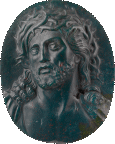| |
Bloodstone
|
Bloodstone, also called Heliotrope is a type of green jasper with red inclusions from which it's name is derived. This is the only combination that may truly be called bloodstone as the inclusion of any other color reclassifies the stone as fancy jasper. It is this association with the blood that led to the belief that it could stop hemorrhaging with but a touch. Eventually the folkloric benefits of this stone was extended to other ailments concerning the blood and bodily health in general.
In addition to this obvious connection there are a few interesting embellishments to this stone’s lore. Damigeron claimed that the stone could be used by conjurers to summon storms and predict the future with thunder. This may have contributed to Greeks calling the stone "heliotrope", which means "sun turning" or "sun reflecting". This secondary translation fits with Pliny’s description of a bloodstone mirror in his possession that he used to observe solar eclipses and other astronomical events.
This stone was ascribed with strangely protective powers in even the earliest written accounts, many of which claimed that the bloodstone would grant invisibility if anointed with the heliotrope flower. Other lapidaries included recipes involving the bloodstone that were intended to make the wearer vanish or be overlooked by his enemies.
Bloodstone amulets would be empowered by the carvings engraved upon them. Though lapidaries often referenced bloodstone amulets that would instill in the wearer an unsurpassed guile, gain the ability to sense deception, or open locked doors; none of these early texts recount the required engraving needed to make any of these amulets. However, King does recount a set of amulets belonging to a Bishop Horsley in his History of Precious stones. In that text he describes one amulet as depicting a seated mercury holding a tortoise, and the other a standing Sol holding a raised whip. Unfortuantly, he does not speak of their purpose, and only briefly mentions that the carvings are of folkloric origin.
Early Christians adopted the bloodstone as a protective amulet because of an old legend that the stones came from Calvery and the red droplets were the preserved blood of Christ. These stones were sought out for religious scenes that were thought to protect from evil and stop bleeding. This belief was expanded by Renaissance lapidaries, who used newly discovered techniques to crate carvings of the crucifixion that incorporated the splotches of red jasper into the wounds of Jesus.
|
Colors
|
Green with red speckles
|
Locations
|
Bloodstone is found worldwide, but many prized specimines come from India.
|
Compisition
|
SiO2, semipellucid crystallized quartz silicate
|
Hardness
|
6 - 7
|
|

|

|

|
|
|
|
|
|